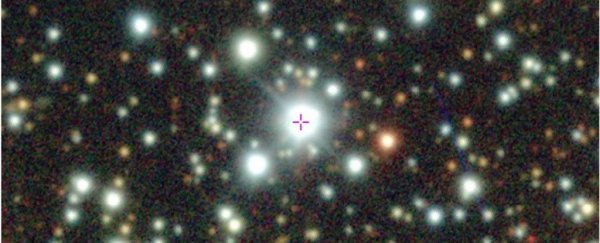There are a lot of unexplained objects out there in the Universe, and astronomers have just found another one – a strange, dusty object that may be causing its host star to dim by up to 75 percent.
Often, when we see something block out the light of its star it's an exoplanet or asteroid. But in this case, the way the object is blocking the light from its star can't be explained by either option: It's both more erratic and more persistent.
Right now, what astronomers can say for sure about the object, known as TIC 400799224, is that it appears to be letting out a whole lot of dust.
TIC 400799224 is orbiting a star system around 2,300 light-years (725 parsecs) away and was first detected by the Transiting Exoplanet Survey Satellite (TESS), which is out hunting for small planets around our neighboring stars.
Using AI to sift through the data collected by TESS, astronomers accidentally stumbled across TIC 400799224 because its dust cloud caused its star to have a rapid drop in brightness of nearly 25 percent over a period of hours, followed by several variations in brightness that could be interpreted as an eclipse.
This would usually signal a disintegrating planet or orbiting body that's being broken down and releasing dust – something scientists are keen to learn more about. But after looking back through six years of data on the mysterious object, the team found that something strange is going on.
Firstly, TIC 400799224 isn't orbiting a single star system. Further examination shows it's orbiting a binary star system, in which one of the stars pulsates with a 19.77-day period.
While that periodicity seems pretty reliable, the object that dims the light is erratic in its shape, depth, and duration – which is why the astronomers assume it's most likely caused by some kind of orbiting body that periodically emits clouds of dust. But it's not clear what exactly that object is.
"The nature of the orbiting body itself is puzzling because the quantity of dust emitted is large; if it were produced by the disintegration of an object like the asteroid Ceres in our Solar System, it would survive only about eight thousand years before disappearing," a press release from the Harvard-Smithsonian Center for Astrophysics explains. One of the Center's astronomers, Karen Collins, was involved in the study.
"Yet remarkably, over the six years that this object has been observed, the periodicity has remained strict and the object emitting the dust apparently has remained intact."
It's also not clear which of the two stars the mysterious object is orbiting, which brings us to another odd thing about this discovery – the originally noticed 25 percent dip in brightness was just a limited example of what TIC 400799224 can do.
Depending on which of the two stars is its true host, the dust the object emits is blocking up to 37 percent or 75 percent of the light from its host star, the researchers explain in The Astronomical Journal.
After crunching the numbers, the researchers do have a few leads. They suggest the data best fits one of the stars being pre-main-sequence, which means the star is still gathering mass from its surrounding envelope of dust and gas, often in the form of a disk around the star.
The team also looked into three possible explanations for the weird dust in their study: 1. disintegration of an object as it passes directly from a solid into a gas state (known as sublimation); 2. collisions with a minor planet-like object releasing sporadic dust clouds; and 3. dust being shepherded by a planet embedded in the star's disk.
The most likely explanation, the team concludes, is the second one – that some planet-like object is colliding around the star and blasting off a whole lot of dust every time it does. This could help explain the regular periodicity of the dust cloud and also the variation in depths.
In the past, similar discoveries had ended up being 'disintegrating planets', but the team felt this data was different enough that this isn't likely what we're seeing here.
"Its detailed properties differ in significant ways from the other objects," the team writes, suggesting "TIC 400799224 may be in a category of its own."
The team plans to continue monitoring the object – and the good news is that it's bright enough that anyone should be able to add their own observations with a decent telescope from their backyard.
Hopefully in the coming years we'll find out more about what's going on with TIC 400799224.
The research has been published in The Astronomical Journal.
